Get free social skills materials every week
No-prep lessons on self-regulation, emotional recognition, conversation skills, and more.
Sign up hereSelf-regulation is one of the most important skills children and adolescents can develop. It helps students manage their emotions, thoughts, and behaviors so they can navigate challenges, build positive relationships, and succeed in school and beyond. From pausing to take a deep breath before reacting to frustration, to staying focused during a difficult task, self-regulation empowers students to make choices that support their well-being and growth.
This comprehensive guide explores what self-regulation is, why it matters, and how adults can support students at every grade level. You’ll find practical strategies, evidence-based approaches, and 20+ downloadable activities to help children and teens strengthen their self-regulation skills in ways that fit their developmental stage and individual needs.
Download 20+ Self-Regulation Activities for PK-12
No-prep tools to teach students how to stay calm, make thoughtful choices, and build emotional awareness.
What Is Self-Regulation?
Self-regulation is a foundational skill that helps children—and adults—manage their emotions, behaviors, and thoughts so they can respond to life’s challenges in positive and productive ways. It’s what allows a child to pause and take a deep breath before reacting in anger, wait patiently for their turn during a game, or keep trying when faced with a difficult task.
Far from simply “self-control,” self-regulation is about understanding and managing internal experiences in a way that aligns with personal goals and social expectations. It’s a dynamic process that involves:
- Emotional regulation — recognizing, expressing, and modulating feelings like frustration, excitement, or anxiety.
- Behavioral regulation — thinking before acting, resisting impulses, and choosing appropriate responses.
- Cognitive regulation (or executive functioning) — planning ahead, problem-solving, staying flexible, and reflecting on actions.
Self-regulation skills begin developing in early childhood and continue to mature through adolescence and into young adulthood. These abilities don’t emerge in isolation; they are shaped by a child’s relationships, environment, and experiences. Adults—whether parents, caregivers, or teachers—play a critical role in this development by providing co-regulation: modeling, guiding, and supporting children as they learn to navigate their emotions and behaviors.
Importantly, self-regulation is teachable. With the right strategies and support, every child can strengthen their ability to manage feelings, stay focused, and act in ways that help them succeed socially and academically.
Why Is Self-Regulation Important?
Strong self-regulation skills are at the heart of a child’s ability to thrive in school—and all areas of life. When children can manage their emotions and behaviors effectively, they are better equipped to:
- Build positive relationships with peers and adults.
- Handle everyday stressors, from waiting in line to tackling a tricky math problem.
- Stay engaged and focused in the classroom.
- Adapt to new situations and recover from setbacks.
In fact, self-regulation is closely linked to academic achievement, mental health, and social success. Research shows that students with well-developed self-regulation skills tend to have stronger peer connections, higher grades, and fewer behavioral challenges at school.
For educators, fostering self-regulation in the classroom leads to a more positive learning environment. Classrooms where self-regulation is actively supported tend to see:
- Fewer disruptions and disciplinary issues.
- Greater student engagement and participation.
- Improved group cooperation and conflict resolution.
Beyond the classroom, self-regulation sets the stage for lifelong resilience. Children who develop these skills early are better prepared to face challenges with confidence, persist through difficulties, and make thoughtful decisions that support their well-being.
Self-Regulation Strategies
Self-regulation grows through intentional teaching, supportive environments, and consistent opportunities for practice. The following self-regulation strategies offer practical ways to help children build the skills they need to manage emotions, thoughts, and behaviors effectively.
- Create a sensory-friendly space. Providing access to fidgets, noise-canceling headphones, or a quiet area helps students meet their sensory needs and reset when overwhelmed. A calming corner with visuals and tools can offer structured support. Consider setting up a Calming Corner to guide children through regulation strategies.
- Use visual supports and clear routines. Visual schedules, first/then boards, and timers make expectations visible and transitions predictable. Paired with consistent routines, these tools help reduce anxiety and promote independence.
- Incorporate mindfulness and movement breaks. Brief breathing exercises, stretches, or grounding activities help students check in with their bodies and emotions. These moments build focus and prevent frustration from escalating. For ideas, explore our interactive yoga library.
- Strengthen emotional literacy. Emotion charts or SocialMojis help students recognize and name their feelings. Regular check-ins and simple reflection questions support thoughtful responses rather than impulsive reactions.
- Model and narrate self-regulation. Adults can demonstrate self-regulation by pausing, identifying emotions, and describing coping strategies in real-time. This modeling provides children with clear examples they can apply themselves.
- Promote self-monitoring and reflection. Encouraging students to track emotions or reflect on strategies builds awareness and accountability. Simple check-in charts and feedback help children identify what supports work best for them.
When these strategies are woven into the daily culture and routines of the classroom, they provide consistent opportunities for all students to build self-regulation skills. This inclusive, proactive approach supports not only individual growth, but also a positive, respectful classroom environment.
Self-Regulation and Neurodivergent Learners
Neurodivergent students often benefit from the same self-regulation strategies as their peers. However, they may need additional flexibility, choices, and scaffolding to build these skills successfully. The following approaches can help support self-regulation in neurodivergent learners:
- Offer choices and personalized supports. What works for one student may not work for another. Providing options—such as different sensory tools, movement breaks, or communication supports—helps students discover what feels comfortable and effective for them.
- Allow for gradual skill development. Some students need more time and practice to build self-regulation strategies. Co-regulation, modeling, and step-by-step guidance can help students gain confidence using these skills over time.
- Use clear routines with built-in flexibility. Predictable routines help reduce stress, but it’s important to remain flexible. Adjusting transitions, pacing, or task demands allows students to stay engaged and regulated throughout the day.
- Create an environment of understanding and respect. Neurodivergent learners are more likely to use self-regulation strategies when they feel safe, seen, and valued. Adults can make a lasting difference by approaching students with empathy and responsiveness.
By combining consistency with flexibility, educators and caregivers can help neurodivergent students build self-regulation skills in ways that honor their individual needs and strengths.
20+ Self-Regulation Activities for PK-12 Students
Download 20+ Self-Regulation Activities for PK-12
No-prep tools to teach students how to stay calm, make thoughtful choices, and build emotional awareness.
Self-Regulation Activities for Pre-K and Kindergarten
Taking Breaks
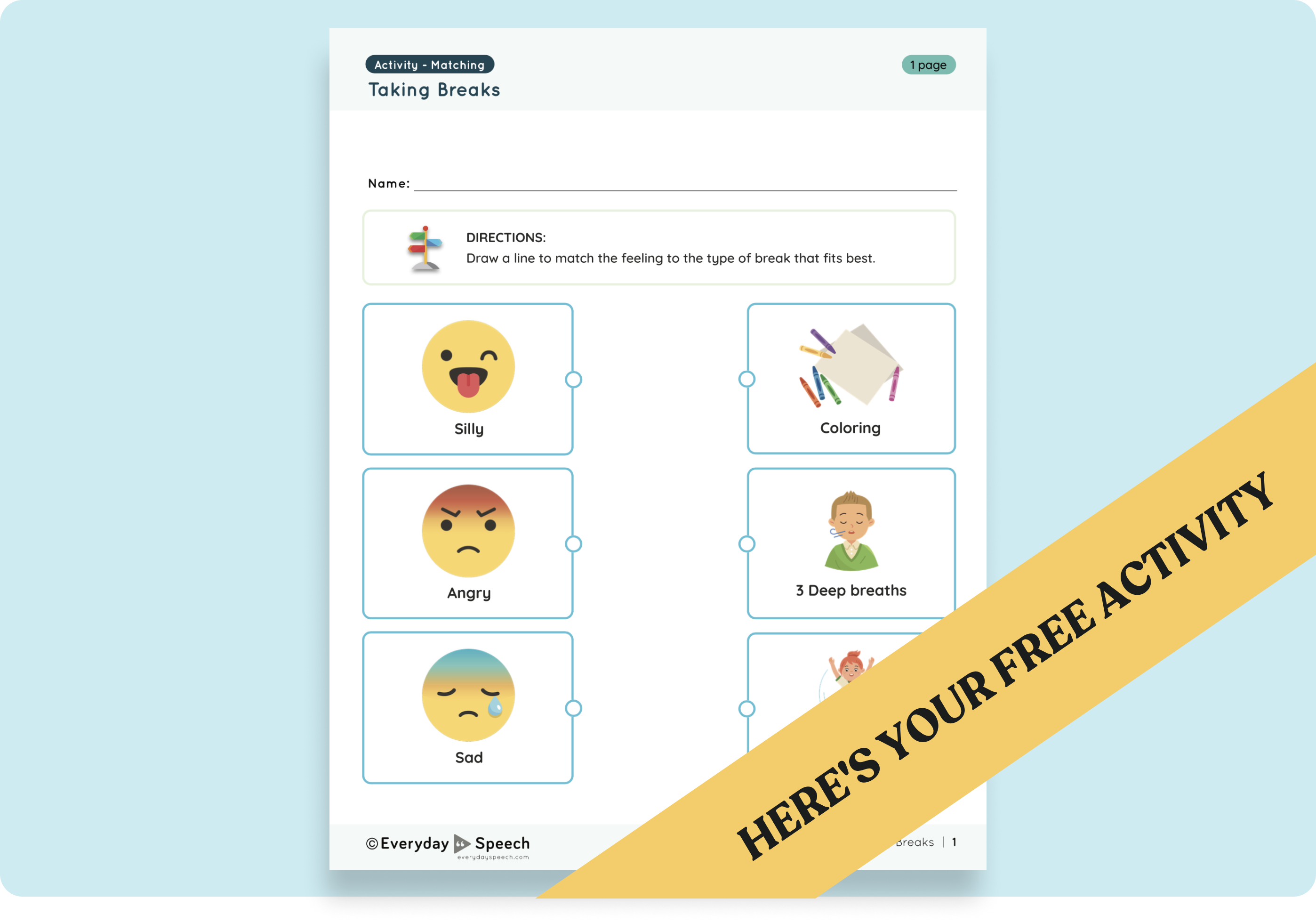
This printable activity introduces young children to the idea of taking a break as a positive way to stay calm when big feelings arise. It helps students recognize early signs of frustration or overstimulation and choose to pause before reacting.
How to use it: Use during group lessons or as part of your classroom calm-down routine. Guide students in practicing break-taking and reinforce it throughout the day with visual cues.
My Worried Toolbox
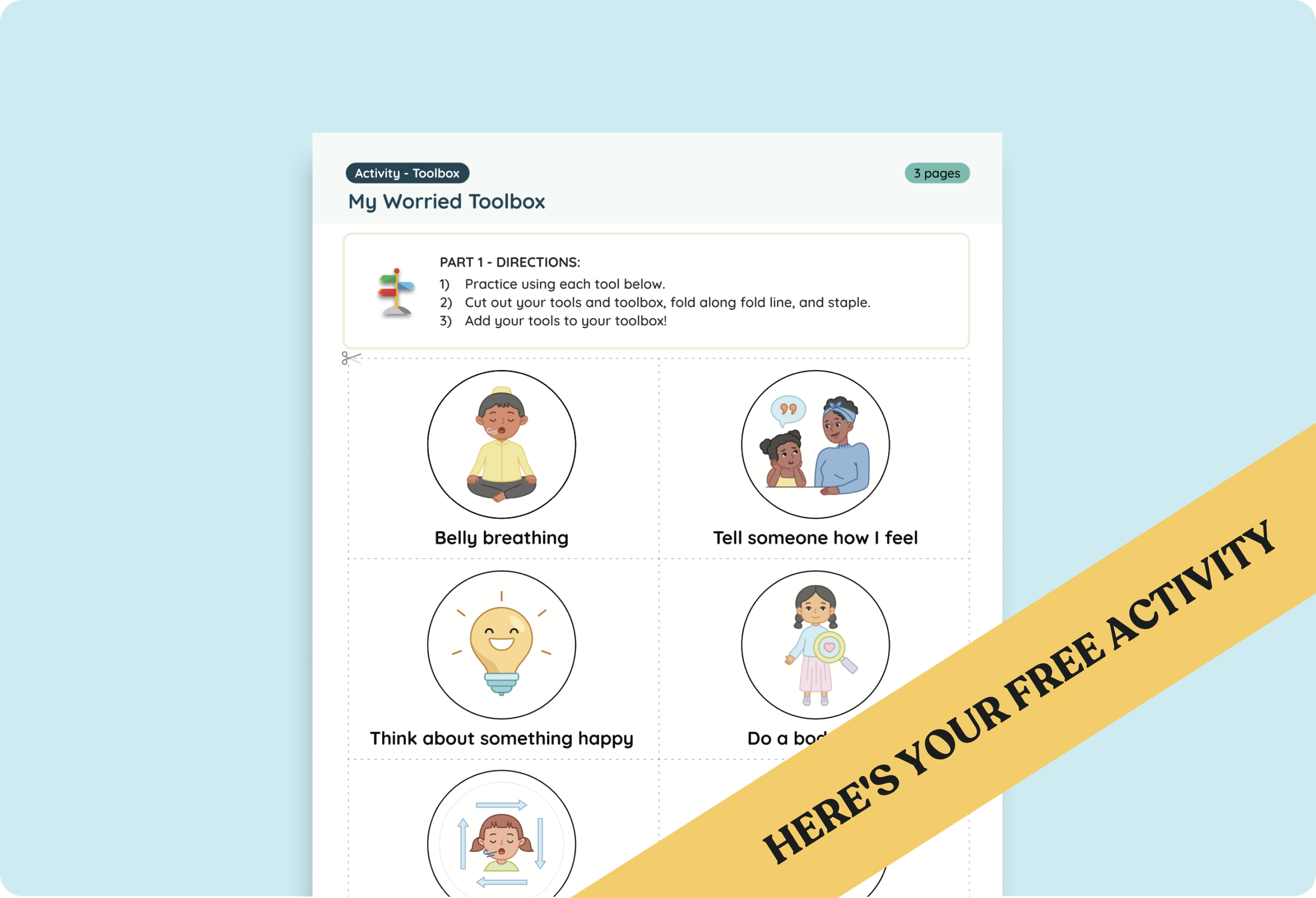
This printable resource helps young learners build a personalized set of calming strategies for moments when they feel worried. With visual icons and simple language, it supports emotional awareness and choice-making.
How to use it: Introduce during small groups or class meetings. Encourage students to personalize their toolboxes and practice strategies like deep breathing, hugging a soft toy, or using positive self-talk.
My Calming Toolbox

This no-prep resource invites students to explore a variety of age-appropriate calming strategies through visuals and hands-on practice. It encourages children to select and personalize tools that help them manage strong feelings.
How to use it: Use during social skills lessons or as part of setting up a classroom calm-down corner. Students can color, cut, and assemble their toolbox, then use it as a reference during the day.
Switching Tracks Goal Poster
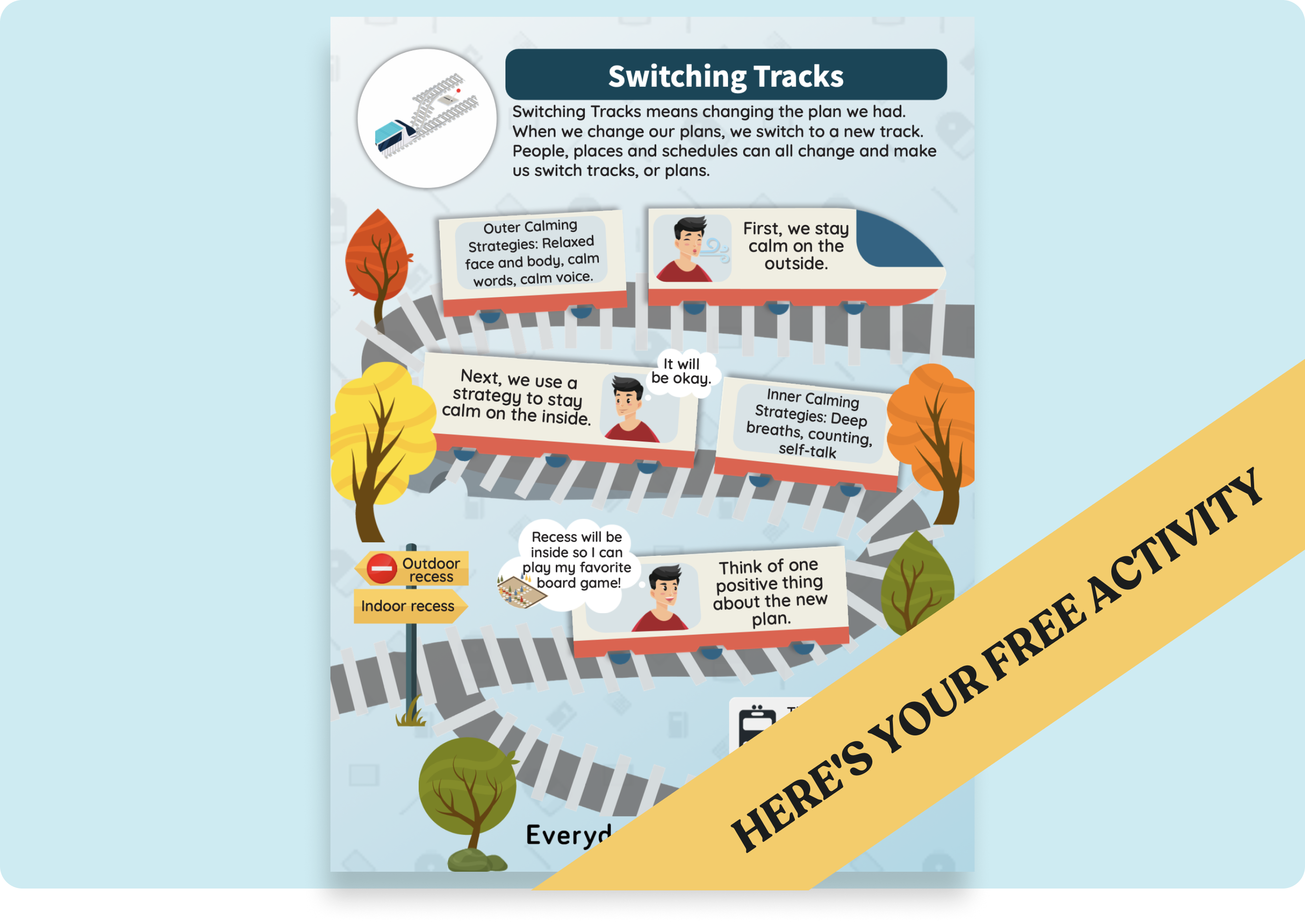
This visual tool supports smooth transitions by guiding students through stopping one activity and starting another. It uses simple steps and images to help children practice flexibility during daily changes.
How to use it: Display the poster in the classroom and refer to it during transitions. Model the steps and prompt students to follow along as part of your transition routines.
I Can Handle Change

This printable helps children develop resilience during unexpected changes in routine. It teaches students to notice their feelings, use self-talk, and choose a coping strategy when plans change.
How to use it: Incorporate into lessons about transitions. Invite students to reflect on times they handled change and use the printable as a tool for group or individual practice.
How I Keep Self-Control

This interactive sequencing activity teaches children the steps of using self-control through visual cards. It helps students internalize the process of pausing, thinking, and choosing positive actions.
How to use it: Use during small groups or centers. Guide students in sequencing the steps and practice with role-plays to apply the concept in real-life scenarios.
Self-Regulation Activities for Elementary School
Finding Strategies That Work for You Video Lesson
This video modeling lesson for self-regulation models a mental check-in process students can use to notice their emotions, identify their needs, and select a coping strategy. The video demonstrates practical examples through relatable student scenarios, supporting emotional self-awareness and independent problem-solving.
How to use it: Show the video during a classroom lesson or small group session. Pause to discuss the scenarios and guide students in applying the Self-Controller Scanner steps to their own experiences.
Deep Breaths Interactive Activity
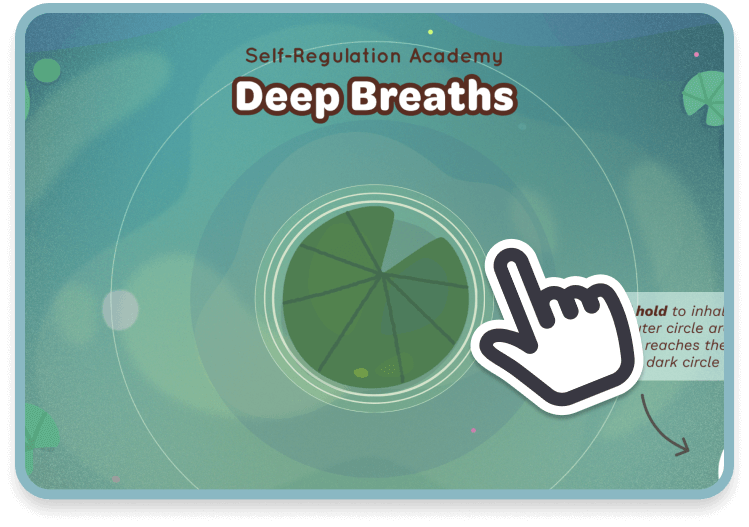
This interactive breathing activity teaches students a structured deep breathing technique to help them calm their bodies and minds during moments of stress or frustration. The activity provides visual and verbal cues to guide practice and reinforce the skill.
How to use it: Introduce during group lessons or as part of a daily regulation routine. Students can follow along individually or as a class, using the visuals and prompts to master the breathing sequence.
Staying Calm Self-Reflection
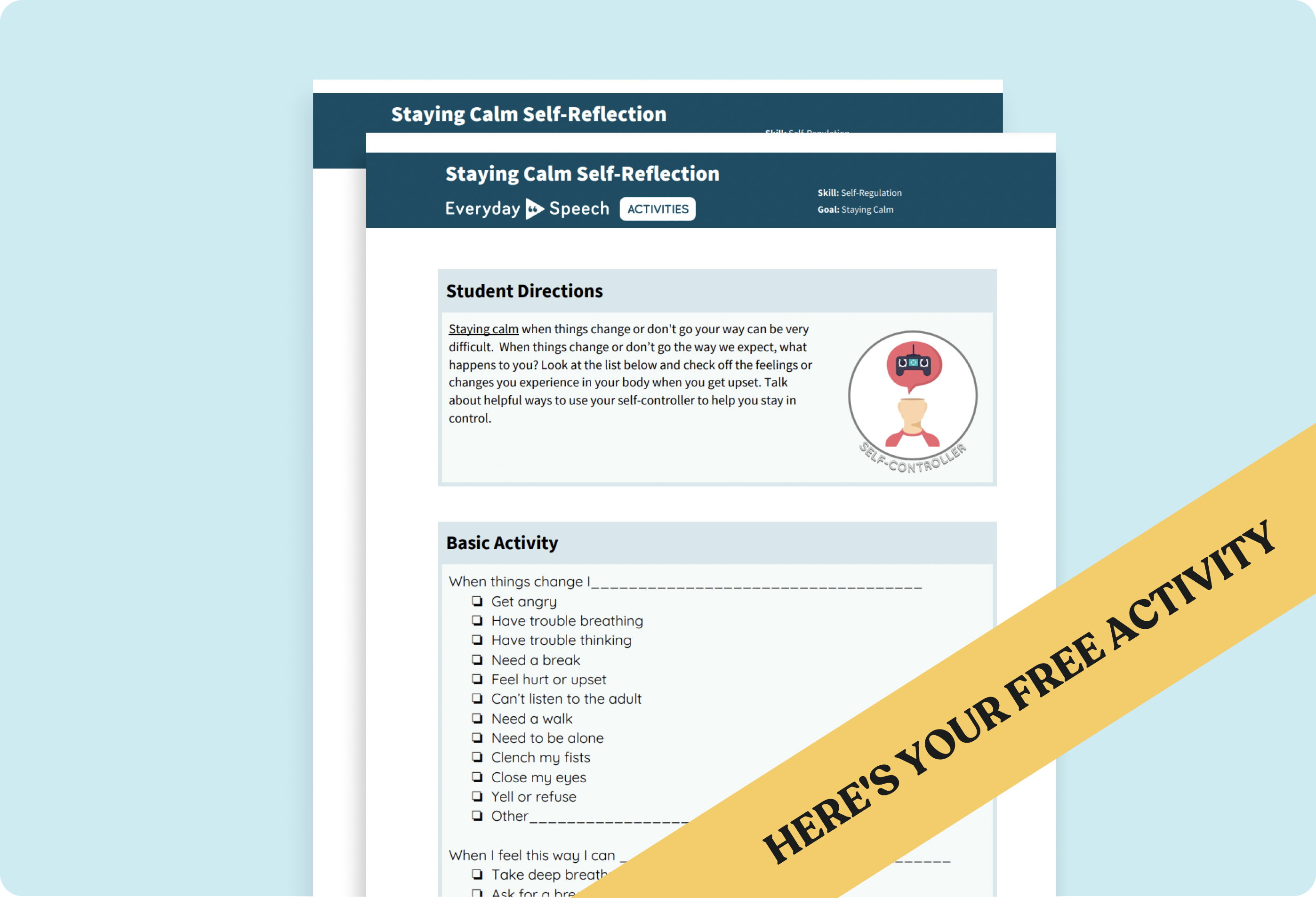
This printable ‘staying calm’ worksheet guides students to recognize what triggers strong emotions, identify how their body feels, and choose calm-down strategies proactively. It supports emotional awareness and helps students connect physical sensations with feelings.
How to use it: Introduce as part of a calm-down routine or during reflection time after challenging moments. Encourage students to complete it individually or with guidance, and discuss their chosen strategies.
Emotion and Solution Choice Bar

This no-prep visual tool for self-regulation helps students identify their current emotion and select a calming strategy that fits the situation. The choice bar format allows students to link feelings with positive actions, promoting independent problem-solving and emotional regulation.
How to use it: Use during classroom routines, transitions, or as part of a calm-down corner. Students can point to or circle their feelings and strategy choices, then reflect on how the strategy worked.
SocialMojis Emotion Check-In

SocialMojis use expressive, emoji-style visuals to help students identify, label, and communicate their emotions in the moment. This activity supports emotional literacy and gives students a concrete tool to check in with themselves during the school day.
How to use it: Invite students to select a SocialMoji that matches their feelings at set times (such as morning meetings or after transitions) or whenever they need support.
Interactive Yoga Breaks
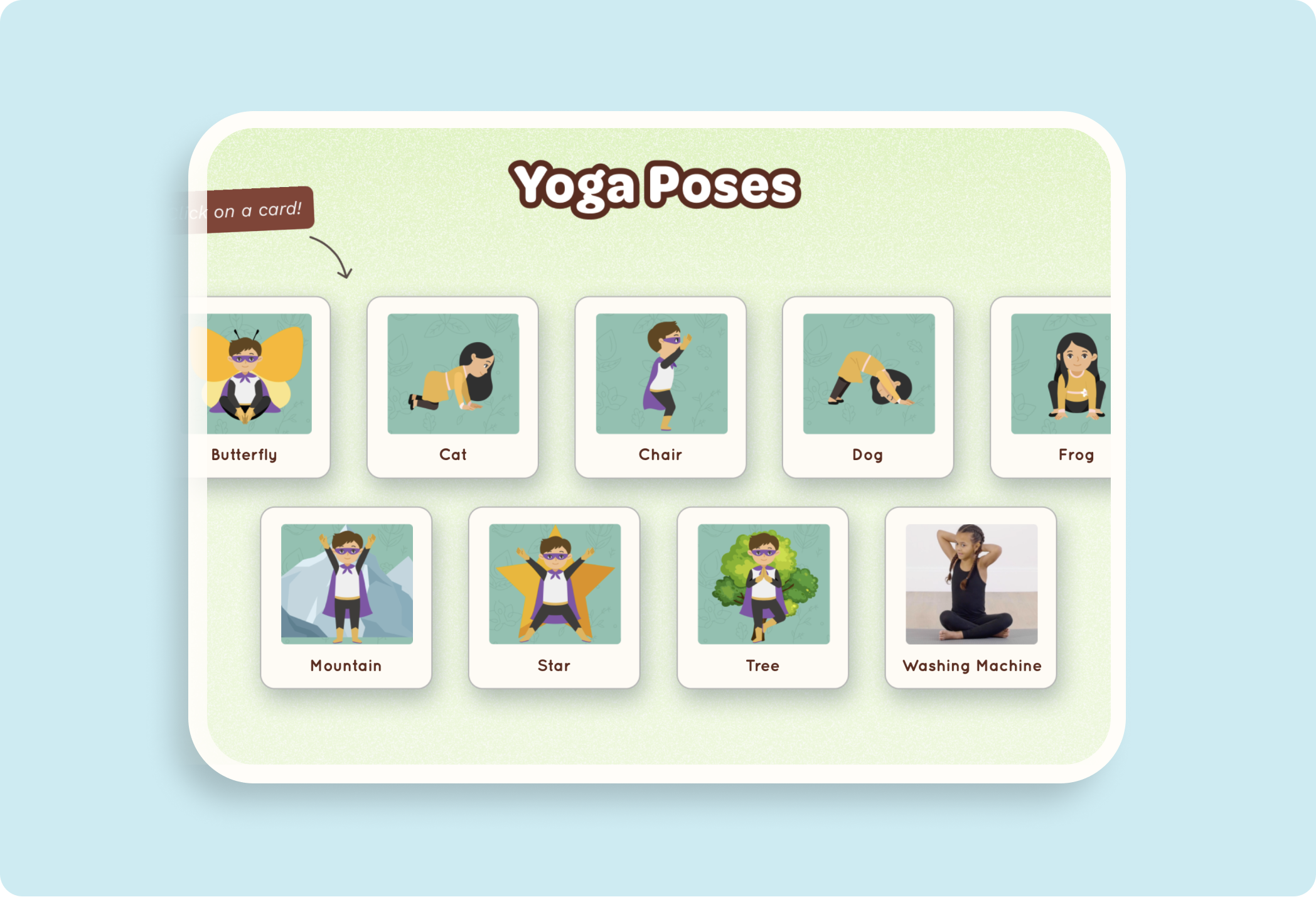
The Interactive Yoga Pose Library provides simple, classroom-friendly yoga poses that help students release energy, refocus, and practice body awareness. This movement-based regulation strategy supports both physical and emotional balance.
How to use it: Select a pose or sequence for students to try during transitions, after high-energy activities, or as part of a classroom calm-down routine.
Self-Regulation Activities for Middle School
Keeping Your Self-Control
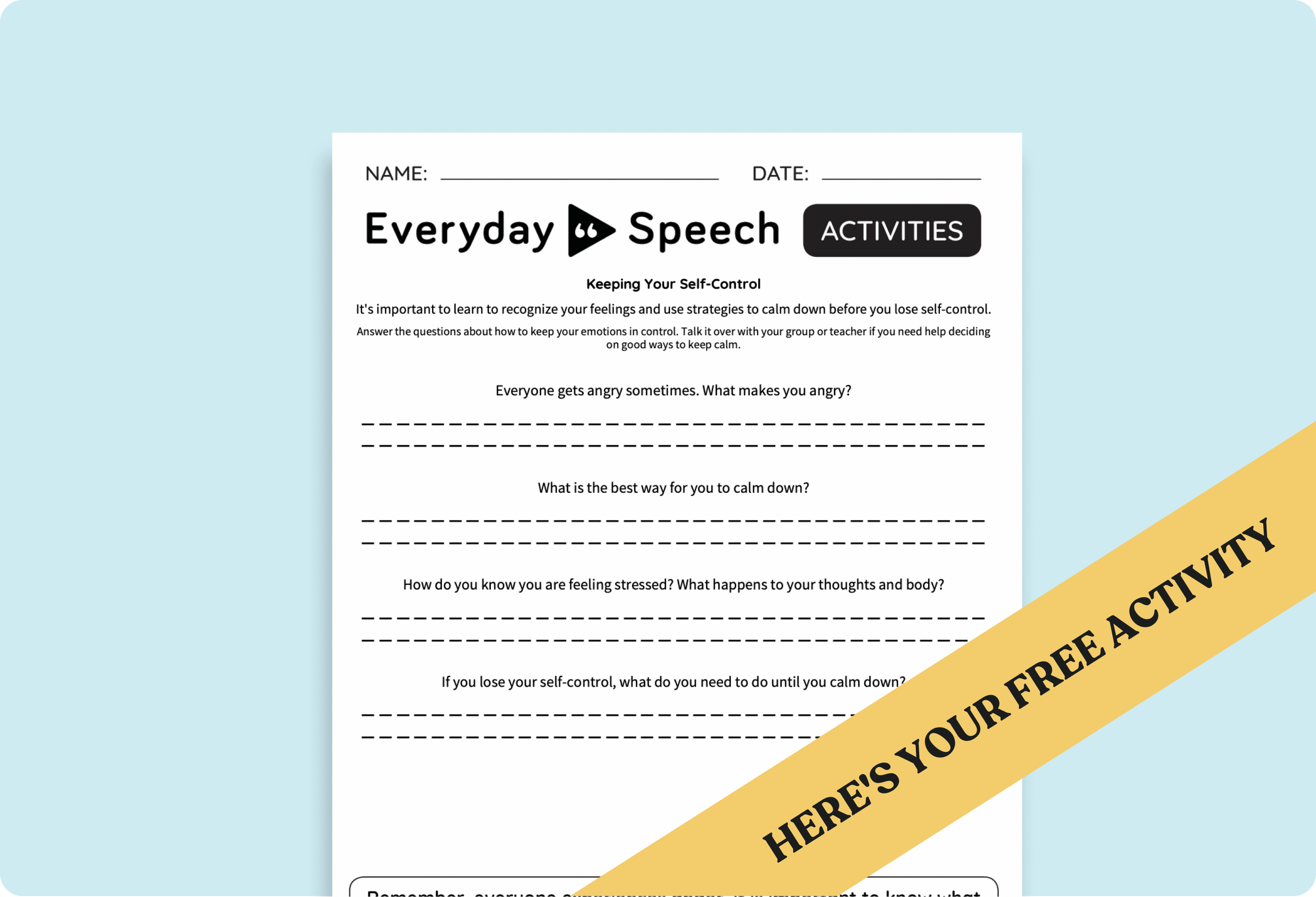
This printable guides students through using their “Self-Controller” to manage strong emotions, pause before reacting, and make thoughtful choices. The worksheet combines relatable scenarios, visual prompts, and reflection questions to help students build self-awareness and decision-making skills.
How to use it: Use during small groups or individual sessions. Guide students through scenarios and encourage them to complete their action plan for handling challenging situations.
Staying Calm Role-Plays

This no-prep resource presents realistic, emotionally charged scenarios that students can act out to practice calming strategies. It helps students identify triggers, apply coping tools, and reflect on their responses in a safe, supportive setting.
How to use it: Use in small groups or pairs. Assign roles, guide students in applying a calming strategy during the scenario, and facilitate discussion afterward.
Staying Calm Goal Poster
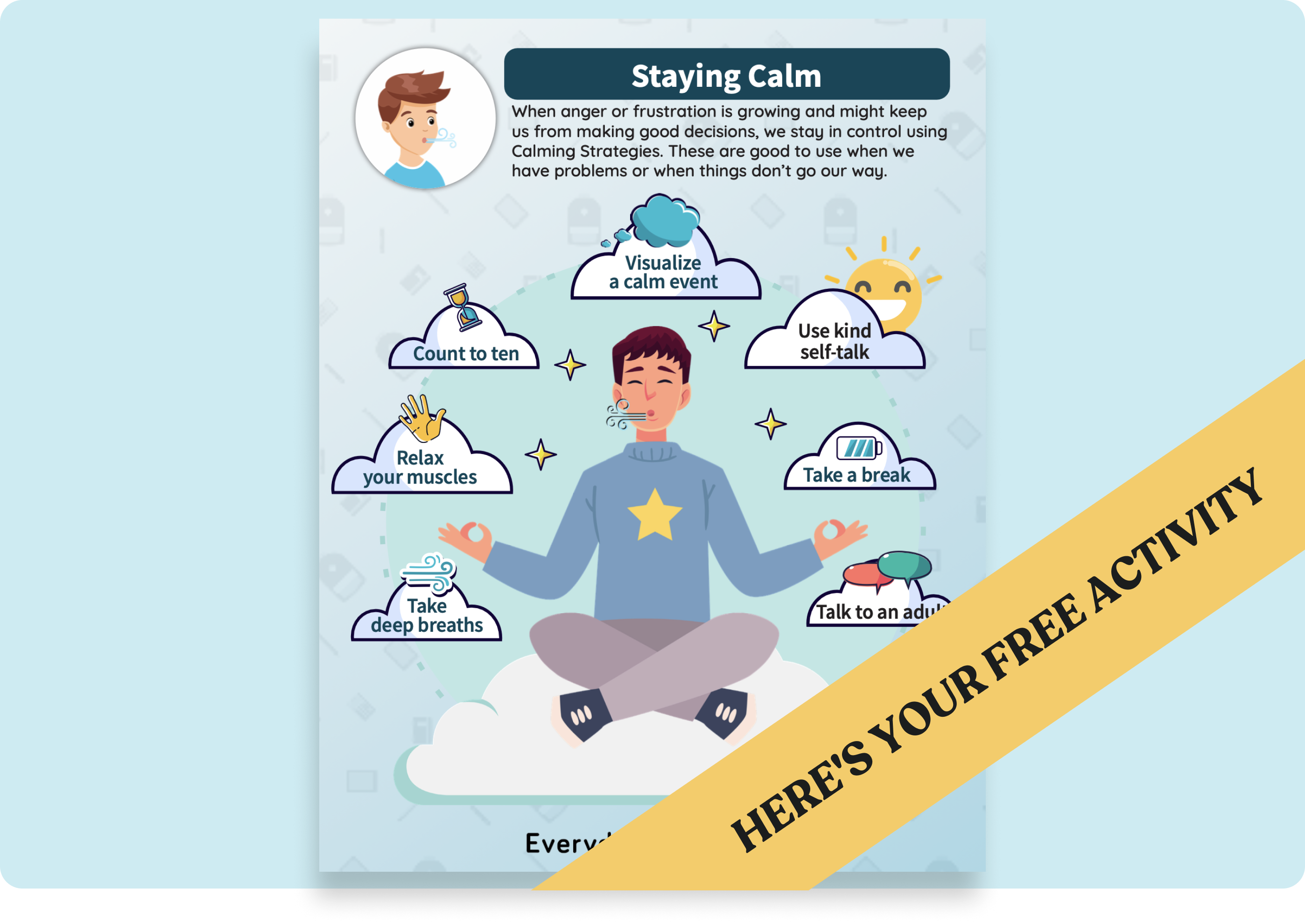
This visual tool breaks down simple steps students can follow to stay calm during stressful moments. The poster emphasizes techniques such as deep breathing, positive self-talk, and goal-setting, supporting independence and resilience.
How to use it: Display in classrooms or counseling spaces. Refer to it during discussions about managing emotions, and encourage students to set personal calm goals.
Self-Controller Scanner Goal Poster
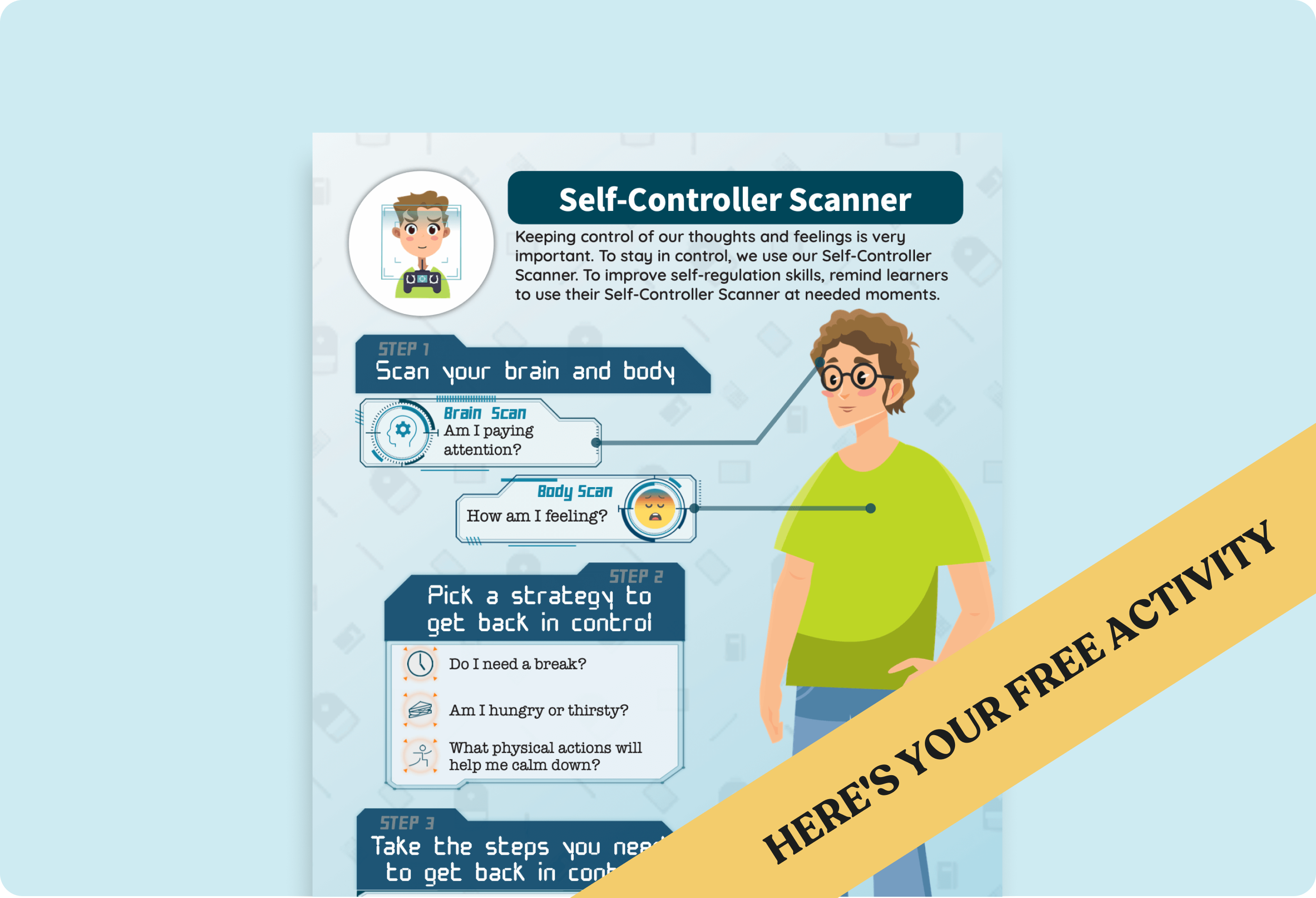
This poster guides students through pausing, checking their “controller,” setting a goal, and choosing a strategy before reacting in challenging situations. It encourages metacognition and empowers students to make thoughtful choices.
How to use it: Use during morning check-ins, transitions, or as part of individual coaching. Pair with role-play or reflection activities to build mastery.
Self-Regulation Activities for High School
Keeping Your Self-Control

This no-prep worksheet invites students to reflect on challenging situations and plan how to pause, access coping strategies, and respond thoughtfully. The activity builds emotional awareness and decision-making skills.
How to use it: Use during counseling sessions or advisory periods. Have students complete the worksheet individually, then discuss strategies in pairs or groups.
Thinking About Others Goal Poster

Originally designed for younger students, this poster can be adapted for teens to support calm, respectful responses in emotionally charged situations. It encourages perspective-taking and helps students reflect on the impact of their actions.
How to use it: Use as a visual anchor during group discussions, restorative circles, or individual coaching. Invite students to set personal calm goals based on the poster’s steps.
Staying Calm Spinner

This interactive tool provides realistic scenarios that prompt students to identify calming strategies they could use in each situation. It builds flexibility and problem-solving skills through peer discussion.
How to use it: Use in small groups or counseling sessions. Have students take turns spinning, responding, and sharing their strategies, then facilitate a group reflection.
Helpful and Unhelpful Strategies
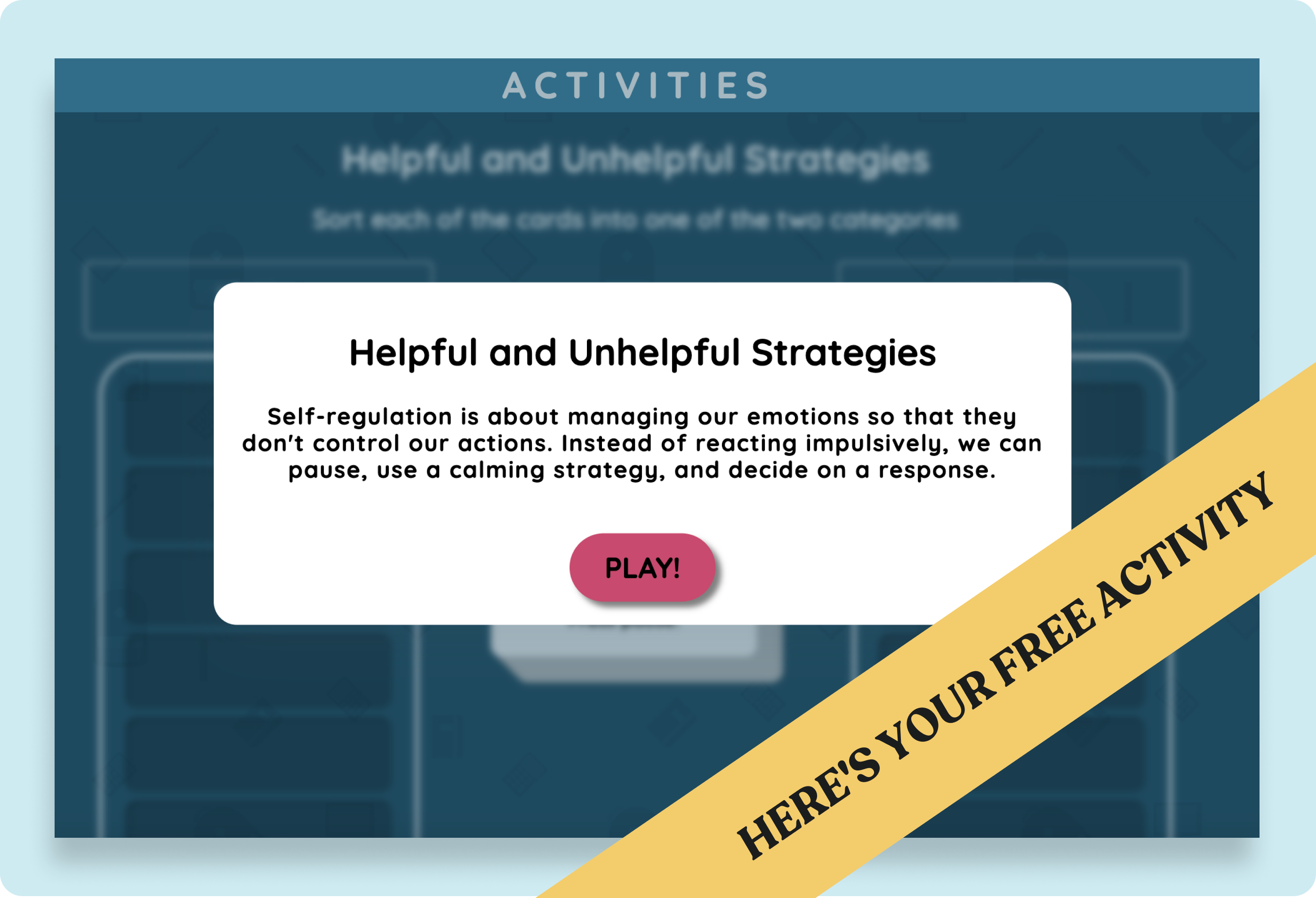
This hands-on sorting activity guides students to categorize common coping strategies as helpful or unhelpful, promoting self-awareness and reflection. It supports students in choosing positive approaches during stress.
How to use it: Use in pairs or small groups. After sorting, lead a discussion on why certain strategies are more effective and how to apply them in daily life.
Switching Tracks: Handling Changes
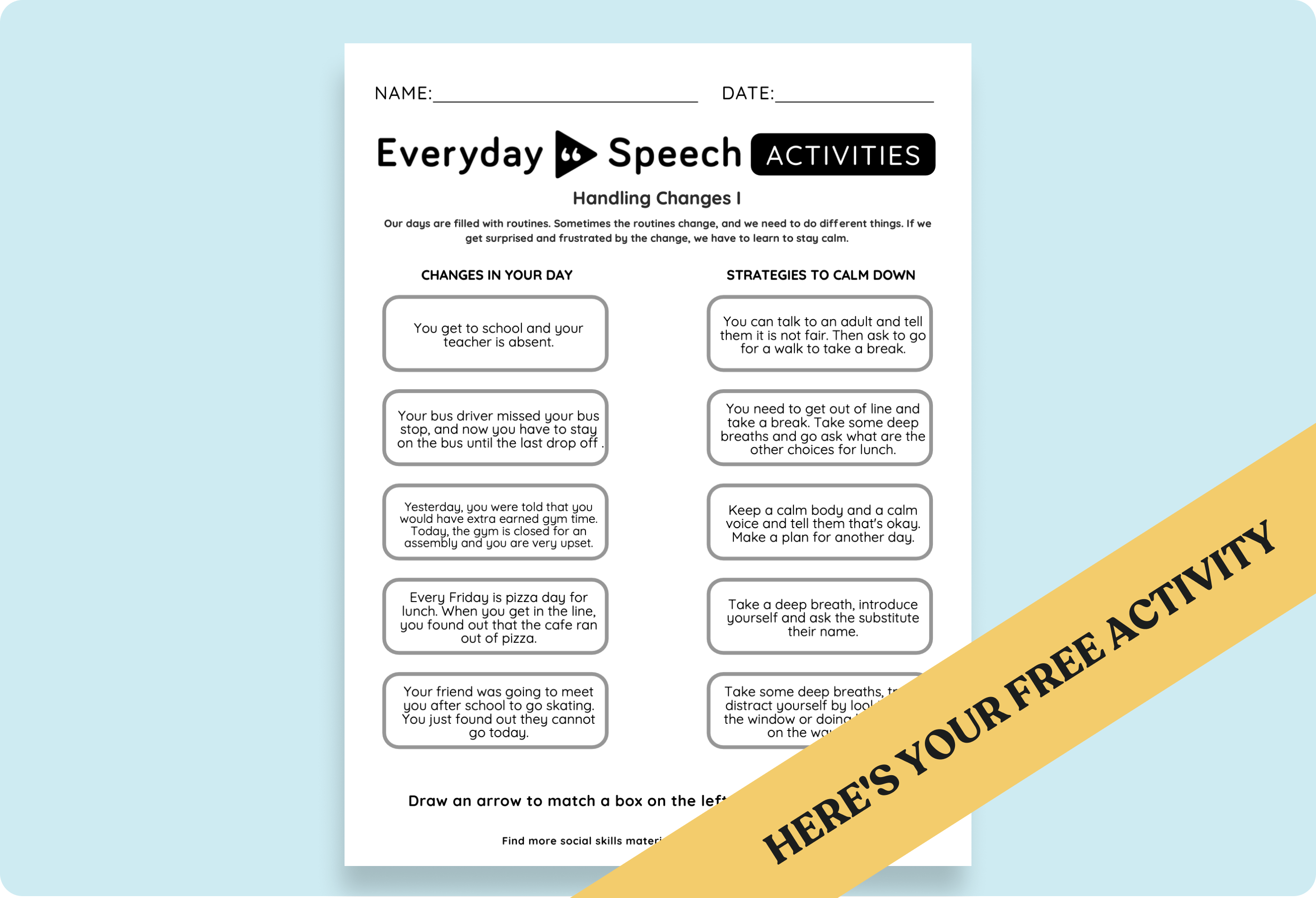
This printable resource helps students build flexibility by practicing how to shift smoothly from one task, plan, or mindset to another. It focuses on strategies for handling unexpected changes with resilience and calm.
How to use it: Use during advisory, life skills classes, or counseling sessions. Guide students in applying the steps to real-life scenarios and setting personal goals for managing transitions.
Using Our Self-Controller at the Holidays
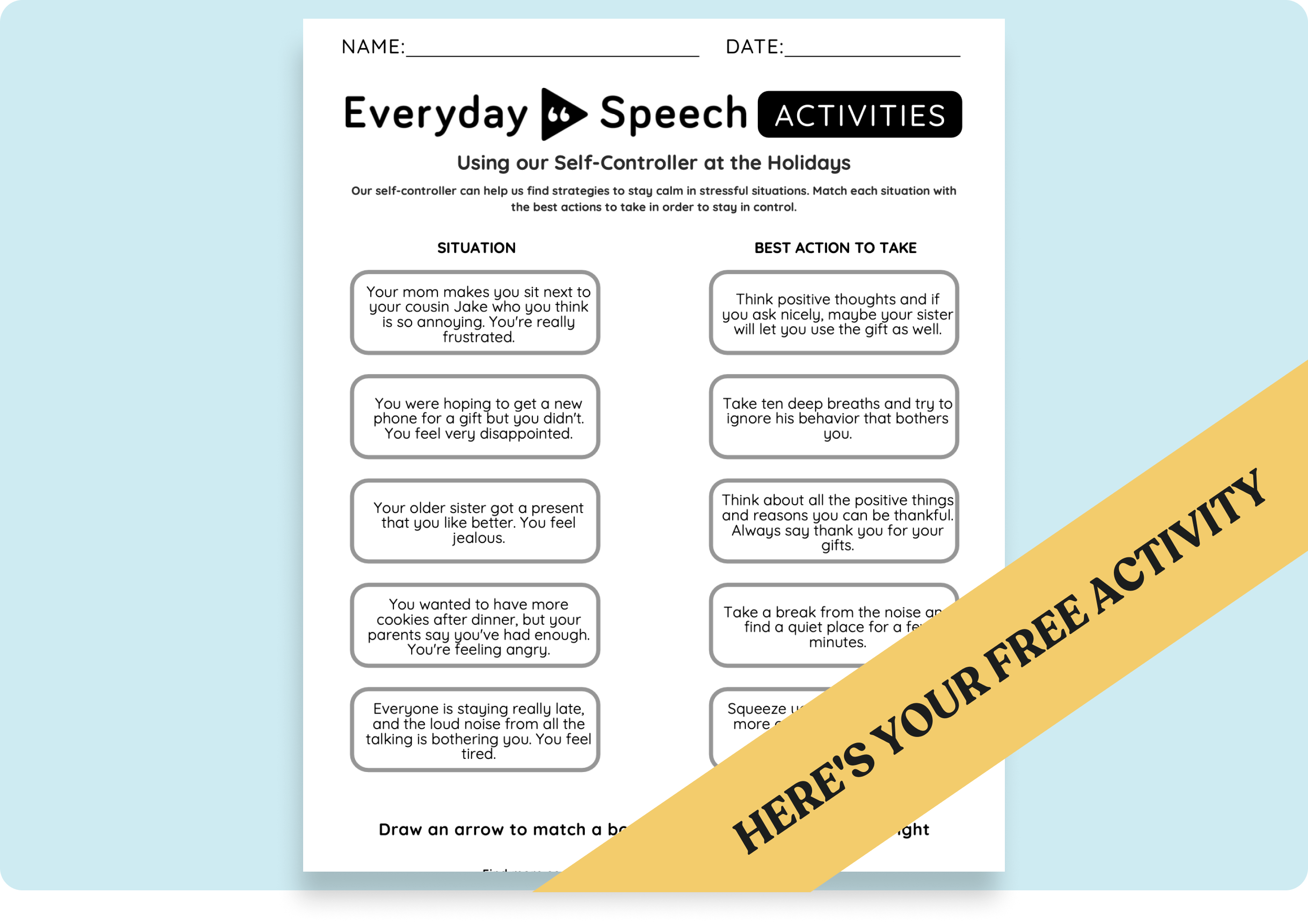
This printable activity helps students identify emotional triggers common during the holiday season and match them with positive coping strategies. It reinforces self-regulation skills in real-world contexts where routines may be disrupted and emotions run high.
How to use it: Use in individual sessions, small groups, or as a classroom station. Guide students in pairing holiday scenarios with self-control strategies, and facilitate reflection or discussion.
Helping Students Build Lasting Self-Regulation Skills
Building self-regulation skills is a lifelong process, but with consistent support, children and teens can learn to manage their emotions, behaviors, and thoughts in healthy, productive ways. Whether at home, in the classroom, or during moments of challenge, the strategies and activities outlined in this guide provide concrete tools to help students practice and strengthen these essential skills.
By creating supportive environments, modeling positive coping strategies, and offering opportunities for reflection and choice, educators and caregivers play a vital role in helping young people develop the self-regulation skills they need to thrive — in school, in relationships, and in life.
Explore the activities linked throughout this page to find ready-to-use resources that make it easy to bring self-regulation practice into your daily routines.
FAQs About Self-Regulation
1. What are signs that a child is struggling with self-regulation?
Signs may include frequent emotional outbursts, difficulty transitioning between activities, impulsive behaviors, or challenges with following directions. A child who struggles with self-regulation may have trouble calming down after becoming upset or managing frustration during social or academic tasks.
2. How can I support self-regulation at home?
Create predictable routines, use visual supports like schedules or timers, and provide spaces where your child can take a break when needed. Modeling coping strategies—such as taking deep breaths or pausing before responding—helps children learn these skills through example. Offering choices and praising efforts to regulate are also powerful supports.
3. What is the difference between self-regulation and self-control?
Self-control typically refers to stopping or inhibiting an impulse in the moment (for example, resisting the urge to interrupt). Self-regulation is a broader skill that involves recognizing emotions, understanding them, and managing them thoughtfully over time to achieve positive outcomes.
4. How long does it take for children to develop self-regulation skills?
Self-regulation skills develop gradually over time, from early childhood into young adulthood. With consistent support and practice, most children show steady growth in these abilities. Some children, particularly those with additional learning or developmental needs, may require extended time and more individualized supports.
5. Are self-regulation strategies the same for all children?
The core strategies—such as using visual supports, building emotional literacy, and practicing mindfulness—can benefit all children. However, it’s important to adapt these strategies to meet individual needs. What works for one student may not work for another, and offering flexibility and choice is key.
6. Can self-regulation be taught at any age?
Yes. While it’s ideal to begin building self-regulation skills in early childhood, these skills can be strengthened at any age with intentional support. Children, adolescents, and even adults can benefit from learning new strategies to manage emotions and behaviors.
7. How can teachers integrate self-regulation practice into the school day?
Self-regulation can be woven into daily routines through activities like morning meetings, emotion check-ins, and structured reflection times. Providing access to regulation tools, designing flexible learning spaces, and modeling coping strategies all help students build these skills as part of their school experience.
